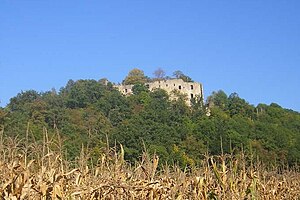Hilgartsberg castle ruins
| Hilgartsberg castle ruins | ||
|---|---|---|
|
Hilgartsberg ruins from the west |
||
| Creation time : | middle Ages | |
| Castle type : | Höhenburg, spur location | |
| Conservation status: | ruin | |
| Place: | Hofkirchen -Hilgartsberg | |
| Geographical location | 48 ° 39 '41.2 " N , 13 ° 9' 9.8" E | |
| Height: | 365 m above sea level NN | |
|
|
||
The Hilgartsberg castle ruin is a castle ruin near Hofkirchen in the Passau district .
Where the Danube leaves the Dungau and enters the breakthrough valley between the southern foothills of the Bavarian Forest , the Hilgartsberg ruin rises behind Hofkirchen on a steep slope on the left.
history
In 1112 an Ezil (Heinrich) de Hilkerirchesberg is mentioned for the first time. The Spur castle then belonged to the county Windberg under the feudal rule of the bishops of Bamberg. Like the other Bamberg fiefs north of the Danube, the Counts of Sulzbach also guarded Hilgartsberg in the 12th century. Extinct when the Counts 1188, the castle fell after a contract between Bamberg and Emperor Frederick I of his sons Otto and Friedrich .
In 1207 it was awarded to the Walchunus von Kamm with other goods . He bequeathed them to his nephews Alram and Albert von Hals and Bernhard von Uttendorf.
There was a protracted dispute with the bishops of Passau and Bamberg, who did not recognize this regulation. In October 1226 an arbitration tribunal finally awarded the rule to Count Rapoto II von Ortenburg . After the death of his son Rapoto III. In 1248, his daughter Elisabeth and her husband Hartmann I von Werdenberg sold the property to Duke Heinrich von Niederbayern in 1259 .
The dukes initially had the castle administered by carers . 1309 Seifried the Puchberger was enfeoffed with it. In 1332 Schweiker I. Tuschl came into pledge ownership of the castle. After his death in 1326, the Ecker von Eck came into possession of the fortress. Since Peter Ecker von Eck fell out of favor with Duke Albrecht , the castle was besieged and taken by the Duke in 1357.
Albrecht equipped the castle with ramparts and a tower in 1360. Now ducal keepers administered Hilgartsberg again. Towards the end of the 15th century the Weisenberger were enfeoffed with it, after their extinction in 1596 it was given to Rudolph Freiherr von Pollweil and Weilerthal. His line died out in 1617, and now Elector Maximilian I lent the estate with the court brands Schöllnstein , Rannetsreit, Garham, Leithen and Oberngschaid to Hanns Ernest Graf Fugger , Herr zu Kirchberg and Weißenhorn.
Although the Fuggers, who exercised higher jurisdiction over the aforementioned court brands, never lived in the castle themselves, they expanded it considerably after the castle fire of 1626. A box belonged to the system where the taxes in kind had to be delivered. In 1698, Count Franz Ernst Fugger acquired the castle and the Hofmark Grubhof as his own property . During the War of the Spanish Succession , Hilgartsberg was occupied by the Austrians in 1704. During the War of the Austrian Succession , it was captured and burned down on November 11, 1742 by the Austro-Hungarian troops led by Lieutenant Colonel Count Gorani.
The Fuggers did not rebuild the ruins. In 1821 Joseph Eligius Graf Fugger zu Glött sold the rule to the Bavarian state. In 1823, the remaining buildings were initially transferred to an innkeeper and farmer from Garham, and later partly to a Vilshofen brewery owner. In 1838 the owners left all buildings free of charge to the state because of the high maintenance costs.
Until 1970 the school of the former Hilgartsberg community was housed here. The school building was sold to the owner of the castle inn. On December 18, 1995, Markt Hofkirchen acquired the Hilgartsberg castle ruins from the Free State of Bavaria. Since then, the castle sponsoring association has maintained the facility and organizes castle festivals and a castle Christmas every year.
description
From the north-east one reaches the outer Zwinger with the well-preserved medieval castle chapel of St. George via a ditch and through a gate . The interior of the chapel dates mainly from the 16th century, the altar from the Rococo period . The altarpiece depicting the Annunciation was probably made in the early 17th century.
A gate tower leads to the inner kennel and another gate tower to the castle courtyard. An open-air theater was built here. In one corner there is a deep well that forms the starting point of an underground passage. It leads under the walls into the outer kennel. The excellent view of the Danube valley is also worth mentioning.
literature
- Karl Wild, Hilgartsberg Castle in the Middle Ages , in: Ostbairische Grenzmarken 7, Passau 1964/65, pp. 272–292.
- Karl Wild, Hilgartsberg Castle . R. Rückert KG, Vilshofen 1979.
- Joseph Klämpfl, the former Schweinach and Quinzingau . 2nd Edition. 1855, reprint 1993, Neue Presse Verlags-GmbH, Passau, ISBN 3-924484-73-2 .
- Günther T. Werner, castles, palaces and ruins in the Bavarian Forest . Verlag Friedrich Pustet, Regensburg 1979, ISBN 3-7917-0603-9 , pp. 45-47.



